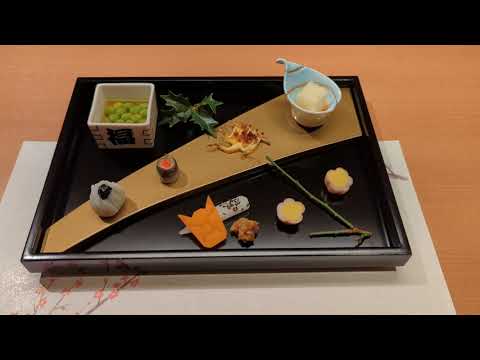We were served dinner in a private room at Bettei Oborozukiyo (別邸 朧月夜), a luxury Onsen (Hot Springs) ryokan in Dogo Onsen, Ehime, Japan (愛媛県道後温泉.) The menu and explanation of the servings were all in Japanese, but I’ve done my best to summarize each course in both English and Japanese below. They are:
COURSE 1 – Zensai (前菜 – Appetizer):
* Usui Mame (うすい豆 – Wakayama Pea Bean)
* Yurine Tofu (百合根豆腐 – Lily Bulb Tofu)
* Shirauo Karasumi Yaki (白魚唐墨焼き – Grilled Ice Fish and Salted Mullet Roe)
* Hiiragi, Iwashi to Mentaiko (柊, 鰯と明太子 – Osmanthus heterophyllus, Sardine & Spicy Cod Roe)
* Imo Sushi with Kuromame in the middle – (芋寿司と黒豆 Potato Sushi with Sweet Black Soybean in the middle)
* Ninjin & Aomi Daikon with Moromi Miso (人参, 青味大根, もろみ味噌 – Carrot shaped like a Demon, Aomi Daikon Radish, Moromi Miso Soybean Paste)
* Uzura Tamago Umenohana Mitate (鶉卵梅の花見立て – Quail Egg Shaped like a Plum Blossom Flower)
COURSE 2 – Kobachi (小鉢 – Small Bowl):
* Sekka-ae (雪花和え – Another name for Okara or Unohana, which is made from simmered Soy Pulp and assorted vegetables)
– Ebi (海老 – Shrimp)
– Shime Aji (鰺 – Cured Japanese Horse Mackerel)
– Kikurage (木耳 – Wood-ear Mushrooms)
– Ninjin (人参 – Carrots)
– Jiku Mitsuba (軸三つ葉 – Japanese Wild Parsley)
– Hanaho Shiso (花穂紫蘇 – Shiso Flowers)
COURSE 3 – Wan (椀 – Soup Dish):
* Sumashi Shitate (清汁仕立 – Clear soup made from Bonito Flakes & Konbu Seaweed Dashi Broth)
– Kani Shinjo (蟹真丈 – Savory Crab Cake)
– Usu Kori Daikon (薄氷大根 – Daikon Radish cut to look like thin ice)
– Shiitake (椎茸 – Shiitake Mushrooms)
– Ninjin (人参 – Carrots)
– Yuzu (ゆず – Yuzu Citrus)
– Jiku Mitsuba (軸三つ葉 – Japanese Wild Parsley)
– Shiraga Negi (白髪葱 – Thin, long Green Onion Strips)
COURSE 4 – Otsukuri (お造り – Sashimi):
* Setouchi Tennen Tai Kasane Zukuri (瀬戸内天然鯛重作り – Wild Red Sea Bream)
* Sayori (サヨリ – Japanese Halfbeak)
* Kuruma-ebi (車海老 – Japanese Tiger Prawn)
* Sawara (鰆 – Japanese Spanish Mackerel)
* Kaku Toro (角トロ – Toro Fatty Tuna cut in a block)
COURSE 5 – Takiawase (炊合せ – Vegetables served with meat, fish or tofu; the ingredients are simmered separately):
* Okoze Mizore-ni (虎魚霙煮 – Stonefish simmered cooked in a soy-based simmering sauce with a plenty of grated daikon that looks like sleet.)
– Uguisu Kinusaya (うぐいす絹さや – Green Peas)
– Ume-fu (梅麩 – Wheat Gluten shaped like a Plum Blossom)
– Kinome (木の芽 – Young leaves of a Sansho plant)
COURSE 6 – Onmono (温物 – Hot Dish):
* FOR HIM: A5 Iyo Gyu Sirloin Shabu Shabu (A5ランク伊予牛サーロインしゃぶしゃぶ)
* FOR HER: Setouchi Tennen Tai Shabu Shabu (瀬戸内天然鯛しゃぶしゃぶ)
– Yasai Nisshiki (野菜一式 – Vegetable set)
COURSE 7 – Kawaribachi (替り鉢 – Replacement Bowl, aka “deviation from the norm”):
* Mascarpone to Milk Soup (マスカルポーネチーズとミルクのスープ – Mascarpone Cheese and Milk Soup)
– Managatsuo (マナガツオ – Japanese Butter Fish / Harvest Fish)
– Kaibashira (貝柱 – Giant Clam Abductor Muscle)
– Koimo (小芋 – Small Potatoes)
– Daikon (大根 – Daikon Radish)
– Nanohana (菜の花 – Young Fern of a Rapeseed Plant)
– Maitake (舞茸 – “Hen-of-the-woods” Maitake Mushroom)
* Kinkan no Kanro-ni (きんかんの甘露煮 – Kumquat simmered in Mizuame Syrup)
COURSE 8 – Shiizakana (強肴 – Large, hot dish):
* Kani Baika-age (蟹梅花揚げ – Deep Fried Crab, Egg Yolk and Bread shaped like a Plum Blossoms and wrapped in Nori Seaweed)
– Fukinoto (蕗の薹 – Edible flower bud of the Fuki Butterbur plant)
– Baika Nagaimo (梅花長芋 – Chinese Yam / Japanese Mountain Yam cut to be shaped like a Plum Blossom)
COURSE 9 – Gohan (御飯 – Rice Dish):
* Kumakogen San Koshihikari (久万高原産こしひかり – Koshihikari Rice from Kumakogen in Ehime)
* Kounomono (香の物 – Pickled Vegetables)
* Matsuyama Shiro Miso Shitate (松山白味噌仕立て – White Miso Soybean Paste Soup, Miso from Matsuyama in Ehime)
– Shijimi (蜆 – Shijimi Clams)
– Daitokuji-fu (大徳寺麩 – Daitokuji Temple Wheat Gluten)
COURSE 10 – Kudamono (果物 – Fruits):
* Ichigo Pudding (苺プリン – Strawberry Pudding)
* Beni Madonna (紅マドンナ)
* Melon (メロン)
* Ichigo (苺 – Strawberry)
* Whipped Cream (ホイップクリーム)
* Mint (ミント)
* Ponkan (ポンカン – Ponkan Mandarin)

